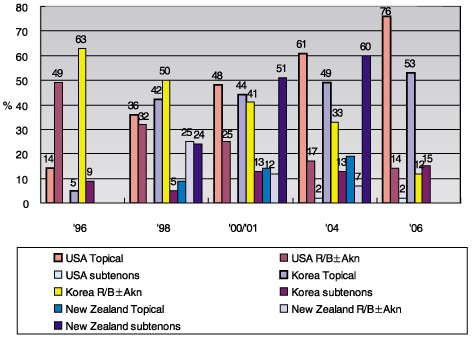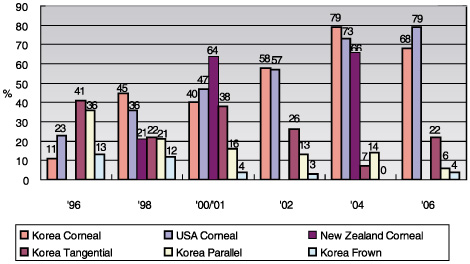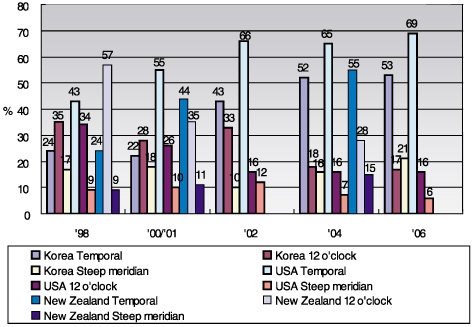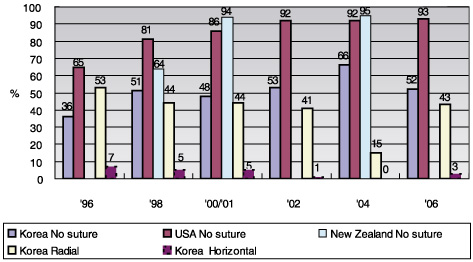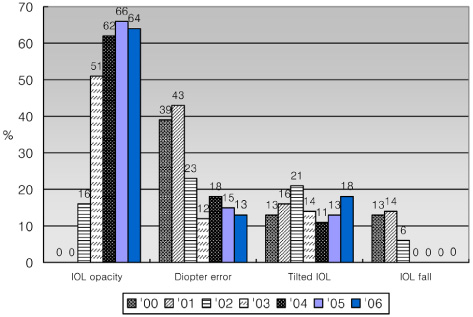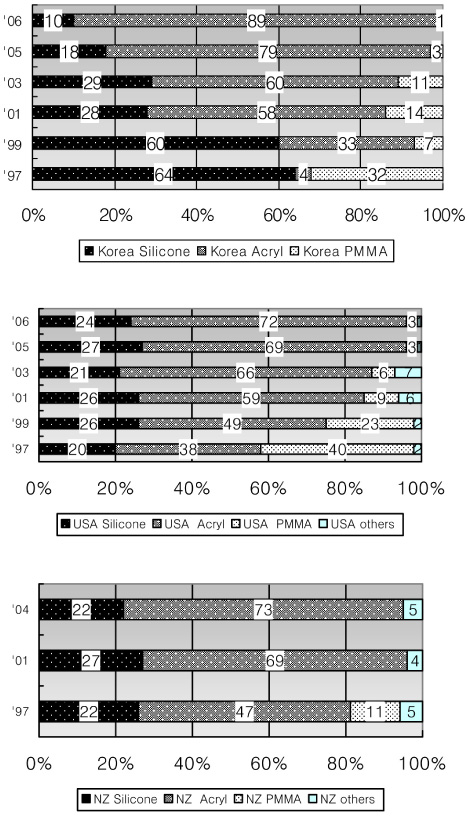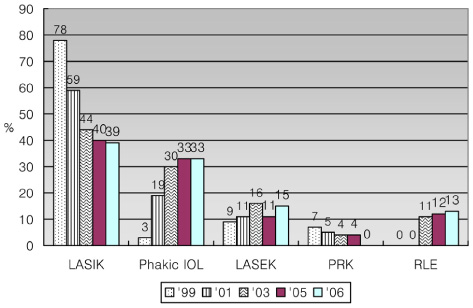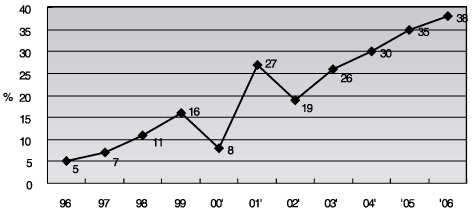Korean J Ophthalmol.
2009 Sep;23(3):142-147. 10.3341/kjo.2009.23.3.142.
Cataract and Refractive Surgery in ; a Survey of KSCRS Members From 1995~2006
- Affiliations
-
- 1Department of Ophthalmology, Gachon University of Medicine and Science, Gil Medical Center, Incheon, Korea. campbell05@naver.com
- KMID: 1115743
- DOI: http://doi.org/10.3341/kjo.2009.23.3.142
Abstract
- PURPOSE
This purpose of this report was to study trends in cataract and refractive surgeries conducted during the past twelve years and to compare results to previous reports from the ASCRS and New Zealand (NZ) in order to forecast future medical services. METHODS: We surveyed members of the Korean Society of Cataract and Refractive Surgery (KSCRS) every year from 1995 to 2006, and studied changes in cataract and refractive surgeries (RS). RESULTS: The duration of hospitalization has been gradually decreasing to the point that a one day hospitalization following surgery has become common. The rate of topical anesthesia use has significantly increased since 1998. Sutureless incision methods are now commonly practiced. The use of acryl IOL as an optic material has been gradually increasing for cataract surgeries. KSCRS members showed an interest in the special intraocular lenses as multifocal IOL. While Excimer laser PRK was the most popular refractive surgery during the first stage, KSCRS members increasingly prefer LASIK to the Excimer laser PRK. Regression of the corrected visual acuity, dry eye, night halo, and flashes were the most common complications following refractive surgeries. Medical disputes related to PRK and LASIK have been gradually increasing throughout the study period. CONCLUSIONS: We confirm that the KSCRS practice styles for cataract and RS are similar to those of the ASCRS and NZ. We infer a world-wide trend from the comparison of these three societies.
Keyword
MeSH Terms
-
Adult
Cataract Extraction/statistics & numerical data/*trends
Humans
Keratomileusis, Laser In Situ/statistics & numerical data/trends
Laser Therapy/statistics & numerical data/trends
Lasers, Excimer
Lenses, Intraocular/statistics & numerical data/trends
Middle Aged
Ophthalmology/statistics & numerical data/*trends
Photorefractive Keratectomy/statistics & numerical data/trends
Professional Practice/statistics & numerical data/*trends
Questionnaires
Refractive Surgical Procedures/statistics & numerical data/*trends
Republic of Korea
Societies, Medical
Figure
Reference
-
1. Shyn KH, Baek NH, Lee JH, et al. Current trends in cataract and refractive surgery in Korea - 1995 Survey for KSCRS Members. J Korean Ophthalmol Soc. 1998. 39:892–899.2. Shyn KH, Shim JK, Park SW. Current trends in cataract and refractive surgery in Korea - 1996 Survey for KSCRS Members. J Korean Ophthalmol Soc. 1999. 40:403–408.3. Shyn KH, Shin SH, Kim JS. Current trends in cataract and refractive surgery in Korea - 1997 Survey for KSCRS Members. J Korean Ophthalmol Soc. 1999. 40:950–958.4. Shyn KH, Park SW, Kim JS. Current trends in cataract and refractive surgery in Korea - 1998 Survey for KSCRS Members. J Korean Ophthalmol Soc. 2000. 41:1523–1531.5. Shyn KH, Oh KH, Park KS. Current trends in cataract and refractive surgery in Korea - 1999 Survey for KSCRS Members. J Korean Ophthalmol Soc. 2001. 42:713–723.6. Shyn KH, Kim YS, Ha SW. Current trends in cataract and refractive surgery in Korea - 2000 Survey for KSCRS Members. J Korean Ophthalmol Soc. 2002. 43:1007–1013.7. Song YS, Lee JH, Shyn KH, et al. Current trends in cataract and refractive surgery in Korea - 2001 Survey for KSCRS Members. J Korean Ophthalmol Soc. 2004. 45:45–54.8. Shyn KH, Han YS, Lee JH. Current trends in cataract and refractive surgery in Korea - 2002 Survey for KSCRS Members. J Korean Ophthalmol Soc. 2004. 45:55–63.9. Shyn KH, Chi MJ, Sohn HJ. Current trends in cataract and refractive surgery in Korea - 2003 Survey for KSCRS Members. J Korean Ophthalmol Soc. 2006. 47:214–220.10. Shyn KH, Bae JW, Moon HS. Current trends in cataract and refractive surgery in Korea - 2004 Survey for KSCRS Members. J Korean Ophthalmol Soc. 2005. 46:35–44.11. Shyn KH, Yoon SC. Current trends in cataract and refractive surgery in Korea-2005 Survey for KSCRS Members. J Korean Ophthalmol Soc. 2007. 48:485–492.12. Leaming DV. Practice styles and preferences of ASCRS members-1996 survey. J Cataract Refract Surg. 1997. 23:527–535.13. Leaming DV. Practice styles and preferences of ASCRS members-1998 survey. J Cataract Refract Surg. 1999. 25:851–859.14. Leaming DV. Practice styles and preferences of ASCRS members-2000 survey. J Cataract Refract Surg. 2001. 27:948–955.15. Leaming DV. Practice styles and preferences of ASCRS members-2002 survey. J Cataract Refract Surg. 2003. 29:1412–1420.16. Sandoval HP, de Castro LE, Vroman DT, Solomon KD. Refractive Surgery Survey 2004. J Cataract Refract Surg. 2005. 31:221–233.17. Elder MJ, Tarr K, Leaming D. The New Zealand cataract and refreactive surgery survey 1997/1998. Clin Experiment Ophthalmol. 2000. 28:89–95.18. Elder MJ, Leaming D. The New Zealand cataract and refreactive surgery survey. 2001. Clin Experiment Ophthalmol. 2003. 31:114–120.19. Elder MJ, Leaming D, Hoy B. The New Zealand cataract and refreactive surgery survey 2004. Clin Experiment Ophthalmol. 2006. 34:401–410.20. Macky TA, Werner L, Soliman MM, et al. Opacification of two hydrophilic acrylic intraocular lenses 3 months after implantation. Ophthalmic Surg Lasers Imaging. 2003. 34:197–202.
- Full Text Links
- Actions
-
Cited
- CITED
-
- Close
- Share
- Similar articles
-
- 2006 Survey for KSCRS Members: Current Trends in Refractive Surgery in Korea
- 2004 Survey for KSCRS Members: Current Trends in Cataract Surgery in Korea
- 2007 Survey for KSCRS Members: Current Trends in Refractive Surgery in Korea
- 2006 Survey for KSCRS Members: Current Trends in Cataract Surgery in Korea
- 2003 Survey for KSCRS Members: Current Trends in Cataract and Refractive Surgery in Korea

